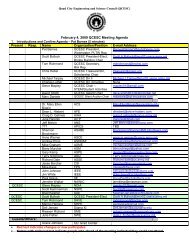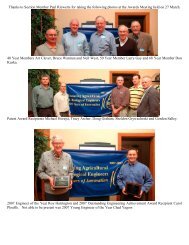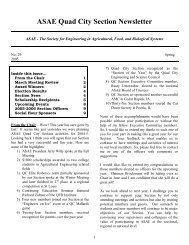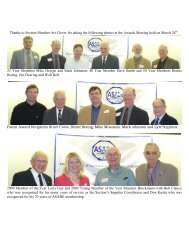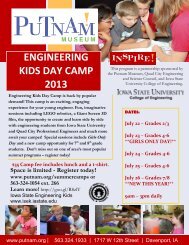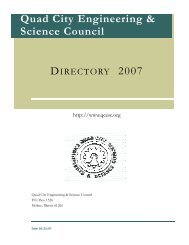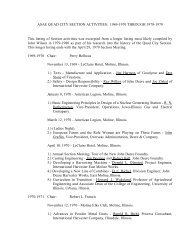Battle of the Bridges - Quad City Engineering and Science Council
Battle of the Bridges - Quad City Engineering and Science Council
Battle of the Bridges - Quad City Engineering and Science Council
You also want an ePaper? Increase the reach of your titles
YUMPU automatically turns print PDFs into web optimized ePapers that Google loves.
6 th Annual QCESC/ASCE <strong>Battle</strong> <strong>of</strong> <strong>the</strong> <strong>Bridges</strong> Fri-Sat, February 8-9, 2013Rules, Tools, Materials2012 “<strong>Battle</strong> <strong>of</strong> <strong>the</strong> <strong>Bridges</strong>” video @ http://www.youtube.com/watch?v=gMgBjHBjcfo&feature=youtu.beObjective:Location:Category:Cost:Schedule:Prizes:Sponsors:To build a model bridge onsite given a box <strong>of</strong> materials provided at <strong>the</strong> workshop within a timelimit <strong>of</strong> 3 hours that is capable <strong>of</strong> supporting <strong>the</strong> greatest load per unit <strong>of</strong> mass.The Putnam Museum1717 West 12 th StreetDavenport, IA 52804The contest is open to any student, grade or age for ei<strong>the</strong>r Friday or Saturday. The primaryreason for <strong>the</strong> Friday session is to raise HS team participation as this is <strong>the</strong> first event <strong>of</strong> threefor <strong>the</strong> QC Tech Challenge. A team may consist <strong>of</strong> one, two, three or four people. All members<strong>of</strong> <strong>the</strong> team must be signed up on <strong>the</strong> registration form.ALL team members must know <strong>the</strong>ir team name @ registration! Elementary (Grades 4-6) Middle School (Grades 7-8) High School (Grades 9-12)College (Ages 18-22, or enrolled in post-secondary degree program)Family (Any combination – kids, adults, seniors)Registration limitations:Friday: 36 teams max (any combination) limited to 9 teams from any one High SchoolSaturday: 36 teams max (any combination), limited to 9 High School teams only$25.00 per team. The cost includes a bridge kit <strong>and</strong> a complete tool kit provided to you at <strong>the</strong>workshop, popcorn & pop. The cost does not include entrance to <strong>the</strong> museum <strong>and</strong>/or <strong>the</strong>atre –not required for event. Scholarships are available upon request to <strong>the</strong> Putnam Museum.Registration Deadline – Thursday, February 7th, 2013. The registration form <strong>and</strong> fur<strong>the</strong>r detailsare available at www.qcesc.org by 12/21/12.If you have any questions, please contact Jeff Melvin @ director@qcesc.orgOR The Putnam Museum’s Alice L<strong>of</strong>f @ 563-324-1054 ext. 266 www.putnam.orgFriday: check-in/setup 11:30 AM - Noon, Bridge Building 12:15-3:15 PM,Load Testing 3:15-4:45 PM (awards on Saturday only)Saturday: check-in/setup 7:30-8:00 AM, Bridge Building 8:15 - 11:15 AM,Load Testing 11:45 AM -1:15 PM, Awards for all categories 1:30-2 PM* Saturday teams will be able to pre-purchase pizza, to be delivered ~11 AM; consult <strong>the</strong> on-lineregistration for details. Sack-lunches are allowed to be eaten in <strong>the</strong> Gr<strong>and</strong> Lobby.<strong>Bridges</strong> with <strong>the</strong> highest structural efficiency (E = maximum load / bridge mass) will be awardedprizes in each category (1rst, 2 nd , 3 rd ) with a “Most Innovative” judged from all.<strong>Quad</strong> <strong>City</strong> <strong>Engineering</strong> <strong>and</strong> <strong>Science</strong> <strong>Council</strong> (QCESC)American Society <strong>of</strong> Civil Engineers (ASCE)PCT Engineered SystemsWestern Illinois University School <strong>of</strong> <strong>Engineering</strong>Saint Ambrose University - <strong>Engineering</strong>Society <strong>of</strong> American Military Engineers (SAME)The Putnam MuseumUniversity <strong>of</strong> Wisconsin - PlattevilleTownsend <strong>Engineering</strong>Ashton <strong>Engineering</strong>Exelon Nuclear – <strong>Quad</strong> CitiesPage 1 <strong>of</strong> 6
6 th Annual QCESC/ASCE <strong>Battle</strong> <strong>of</strong> <strong>the</strong> <strong>Bridges</strong> Fri-Sat, February 8-9, 2013Rules, Tools, MaterialsBridge Building Guidelines:1. Prior to <strong>the</strong> <strong>Battle</strong> <strong>of</strong> <strong>the</strong> <strong>Bridges</strong> contest, we encourage you to explore on <strong>the</strong> internet o<strong>the</strong>r bridgecontests, bridge building tips or at <strong>the</strong> very least consider some <strong>of</strong> <strong>the</strong> guidelines provided below. Thiswill help you generate ideas prior to contest day. The material <strong>and</strong> tool lists will be available 12/19/12 @www.qcesc.org – you are encouraged to experiment during <strong>the</strong> two weeks before <strong>the</strong> event.A 10-minute tutorial will be given before <strong>the</strong> 3-hour “build” session; Engineers will be available toanswer questions.2. See pages 5 & 6 for ASCE bridge building basics. Some excellent websites to begin generating ideas,learn more about bridges, bridge building <strong>and</strong> o<strong>the</strong>r bridge contest are listed below:http://www.bridgesite.com/fun<strong>and</strong>.htmhttp://www.instructables.com/id/Popsicle-Stick-Bridge/http://www.garrettsbridges.com/category/popsicle-bridges/http://<strong>and</strong>rew.triumf.ca/<strong>and</strong>rew/popsicle-bridge/(free s<strong>of</strong>tware) West Point Bridge Designer 2012 @ http://bridgecontest.usma.edu/download.htm3. For additional bridge ideas look around at real bridges. Remember that for a real bridge, <strong>the</strong> importantpart is not <strong>the</strong> deck that <strong>the</strong> cars drive on, but <strong>the</strong> steel or concrete structure that supports <strong>the</strong> deck.4. Your bridge needs to have a solid, stiff shape in all 3 dimensions. Engineers call this “maximizing <strong>the</strong>moment <strong>of</strong> inertia” <strong>of</strong> your structure. For example, take a Popsicle stick on its flat side <strong>and</strong> have itoverhang from <strong>the</strong> edge <strong>of</strong> a table. Then, apply a bit <strong>of</strong> force with your fingers at <strong>the</strong> loose end <strong>and</strong>notice <strong>the</strong> deflection <strong>of</strong> <strong>the</strong> stick. Now, try <strong>the</strong> same thing; but, this time place <strong>the</strong> stick on its edge <strong>and</strong>try to bend <strong>the</strong> stick now. Notice how <strong>the</strong> stick is much stiffer <strong>and</strong> stronger when on its edge?5. A bunch <strong>of</strong> sticks glued toge<strong>the</strong>r flat, like a raft, has very little strength <strong>and</strong> will sag during testing undervery little load.6. The strongest structural shape is <strong>the</strong> triangle. A bridge which is made <strong>of</strong> a series <strong>of</strong> triangles will bevery strong.7. A bridge that is symmetrical is less likely to twist when loaded <strong>and</strong> will probably carry more load.8. <strong>Bridges</strong> which are built too tall will have a high moment <strong>of</strong> inertia (which increases stiffness <strong>and</strong>strength – a good thing); however, <strong>the</strong>y may become unstable under a load (a bad thing). This maycause your bridge to twist or topple to one side <strong>and</strong>…well, you can guess.Bridge Contest Rules, Testing <strong>and</strong> Evaluation:<strong>Bridges</strong> are designed <strong>and</strong> built by Civil Engineers, who are guided in <strong>the</strong>ir work by <strong>the</strong> rules <strong>of</strong> physics, buildingcodes <strong>and</strong> a code <strong>of</strong> ethics. Building codes are based on public health <strong>and</strong> safety. Fairness is <strong>the</strong> basis <strong>of</strong> acode <strong>of</strong> ethics, which guides Engineers to treat <strong>the</strong>ir clients <strong>and</strong> competitors fairly <strong>and</strong> respectfully. The rules<strong>of</strong> this competition reflect building codes <strong>and</strong> engineers’ codes <strong>of</strong> ethics.Note: QCESC will inspect each bridge prior to weigh-in to verify compliance1. Teams will build bridges within a time limit <strong>of</strong> 3 hours, on site, using a box <strong>of</strong> materials provided at <strong>the</strong>workshop. Each team should have as its goal to build a bridge that is capable <strong>of</strong> supporting <strong>the</strong>greatest load per unit <strong>of</strong> mass <strong>of</strong> bridge material. Each team should perform its own work, both design<strong>and</strong> construction. The team may ask <strong>the</strong> contest judges for suggestions. NO pre-constructed bridgecomponents are allowed to be used, even for modeling – written plans ARE permitted.2. Tools: each team will be provided a st<strong>and</strong>ard set <strong>of</strong> tools, to be turned in to <strong>the</strong> QCESC prior to leaving<strong>the</strong> building area for testing. No tool, whole or in part, may be built into <strong>the</strong> bridge itself.Page 2 <strong>of</strong> 6
6 th Annual QCESC/ASCE <strong>Battle</strong> <strong>of</strong> <strong>the</strong> <strong>Bridges</strong> Fri-Sat, February 8-9, 2013Rules, Tools, Materials3. Bridge models will be loaded at <strong>the</strong> middle <strong>of</strong> <strong>the</strong> span. Care should be taken in <strong>the</strong> design to reinforcethis area as well as <strong>the</strong> end supports with bracing. The load, supplied <strong>and</strong> applied by <strong>the</strong> judges, shallhang from <strong>the</strong> bridge. The load will be applied downward, from below, by means <strong>of</strong> a rectangular plate(approximately 6”x1”x1/8” thick) resting on <strong>the</strong> loading plane <strong>of</strong> <strong>the</strong> bridge. The loading plate will beparallel to <strong>the</strong> axial axis <strong>of</strong> <strong>the</strong> bridge at <strong>the</strong> time <strong>of</strong> load application. The plate will have an eyeboltattached from below at its center. Weights will be suspended from this eyebolt. <strong>Bridges</strong> must bedesigned to accommodate <strong>the</strong> loading apparatus.4. The weight <strong>of</strong> <strong>the</strong> bridge will be recorded prior to testing, after inspection by <strong>the</strong> QCESC (see #11)5. The load shall be increased until <strong>the</strong> bridge fails. The largest load will be recorded for each bridge.6. The bridge will be judged based on <strong>the</strong> highest efficiency rating (E = maximum load / bridge mass).7. Testing will consist <strong>of</strong> <strong>the</strong> application <strong>of</strong> an increasing load until <strong>the</strong> bridge breaks. The peak loadrecorded up to this point will be considered <strong>the</strong> breaking load.8. Bridge length: maximum 24-inches; minimum 19-inches. Bridge must span a gap <strong>of</strong> 18-inches (a wood“fixture” is provided to each team to model this 18-inch span).9. Bridge height: 9” max above <strong>the</strong> deck, 9” max below <strong>the</strong> deck; combined total above <strong>and</strong> below = 12”10. Bridge width: maximum 6 inches; minimum 4 inches. Must have deck system across <strong>the</strong> entire portion<strong>of</strong> <strong>the</strong> bridge that spans <strong>the</strong> 18-inch gap between supports.11. The bridge deck must be able to support a weighted toy truck (~3” high, 2.5” wide, ≤ 5 lbs.) as it isrolled <strong>the</strong> entire length <strong>of</strong> <strong>the</strong> bridge – to verify that <strong>the</strong> bridge acts as a bridge.12. In <strong>the</strong> event <strong>of</strong> a tie or multiple bridges with <strong>the</strong> same efficiency rating, <strong>the</strong> lightest bridge wins. It is upto your team to decide on <strong>the</strong> optimum balance between mass <strong>and</strong> strength.13. Judges will be provided by <strong>the</strong> contest sponsors. All decisions <strong>of</strong> <strong>the</strong> judges are final.14. The rules will be finalized <strong>and</strong> posted @ www.qcesc.org not later than 12/19/12 for this competition.Be creative <strong>and</strong> have fun!! ! We look forward to seeing you build your amazing bridges!Note: Photos taken by <strong>the</strong> QCESC or its agent are <strong>the</strong> property <strong>of</strong> <strong>the</strong> QCESC – release forms will need tobe signed at <strong>the</strong> Putnam Museum <strong>the</strong> day <strong>of</strong> <strong>the</strong> event.Pre-Weigh-In Bridge Inspection Checklist:Bridge length: maximum 24-inches; minimum 19-inchesBridge spans a gap 18-inchesBridge height: ≤ 9” above deck, ≤ 9” below deck, ≤ 12” totalBridge width: maximum 6 inches; minimum 4 inchesDeck system across <strong>the</strong> entire portion <strong>of</strong> <strong>the</strong> bridge that spans <strong>the</strong> gapDeck capable <strong>of</strong> supporting weighted toy truckAssembly area inspected before team tests <strong>the</strong>ir bridgeAcceptable?YYYYYYYPage 3 <strong>of</strong> 6
6 th Annual QCESC/ASCE <strong>Battle</strong> <strong>of</strong> <strong>the</strong> <strong>Bridges</strong> Fri-Sat, February 8-9, 2013Rules, Tools, MaterialsTOOLSOnly tools provided by <strong>the</strong> QCESC may be used during this eventNo “tools” are allowed to be included (whole or in part) in <strong>the</strong> final bridge to be tested.1/2 Round FileYardstickMini-pliers w/ wire snipsNitrile (non-latex) glovesCoping saw6” Utility CalipersClo<strong>the</strong>spins (~30 per team)Utility knifeCutting boardWood Fixture (to mimic <strong>the</strong> span)8” Triangle Carpenter SquareBRIDGE BUILDING MATERIAL KIT(Available at craft/hobby/hardware stores throughout <strong>the</strong> <strong>Quad</strong> Cities)Glue – three - 4 gram tubes <strong>of</strong> Loctite p/n 39202 Quicktite Gel or equivalent Ethyl CyanoacrylateString (small ball)Masking Tape (available upon request)Roadway PiecesPoster board 21x3 1/4" 1 eaPopsicle Sticks5 7/8 x 3/4 x 1/16" 120 ea4 1/2 x 3/8 x 1/16" 80 ea5 1/2 x 1/4 x 1/16" 80 eaWood PiecesRound Dowels - 36" x 1/8" 2 eaSquare Dowels - 36" x 1/4" 2 ea24" x 3/16" 2 ea(This LOCTITE is <strong>the</strong> widely available equivalent)Page 4 <strong>of</strong> 6
Bridge Building BasicsTYPES OF BRIDGES:Arch Tied Arch Basket H<strong>and</strong>le ArchSuspensionTrussCable StayLOAD PATH:COMPRESSION +TENSION - Streng<strong>the</strong>n areas where loads are concentrated (Load Point <strong>and</strong> Abutments)CONNECTIONS: <strong>Bridges</strong> are only as strong as <strong>the</strong>ir connections: Reinforce JointsPage 5 <strong>of</strong> 6
STABILITY: Use triangular shapes to prevent rectangles from leaning Compression members such as <strong>the</strong> Top Chord will try to buckle sidewaysduring loading. Prevent by using bracing such as Top Lateral Bracing. Think about stability in <strong>the</strong> width direction <strong>of</strong> your bridge. Prevent twistingby using a "closed" shape such as a box or triangle as opposed to an "open"U-shape.EXAMPLES OF TRUSS TYPES:Page 6 <strong>of</strong> 6




